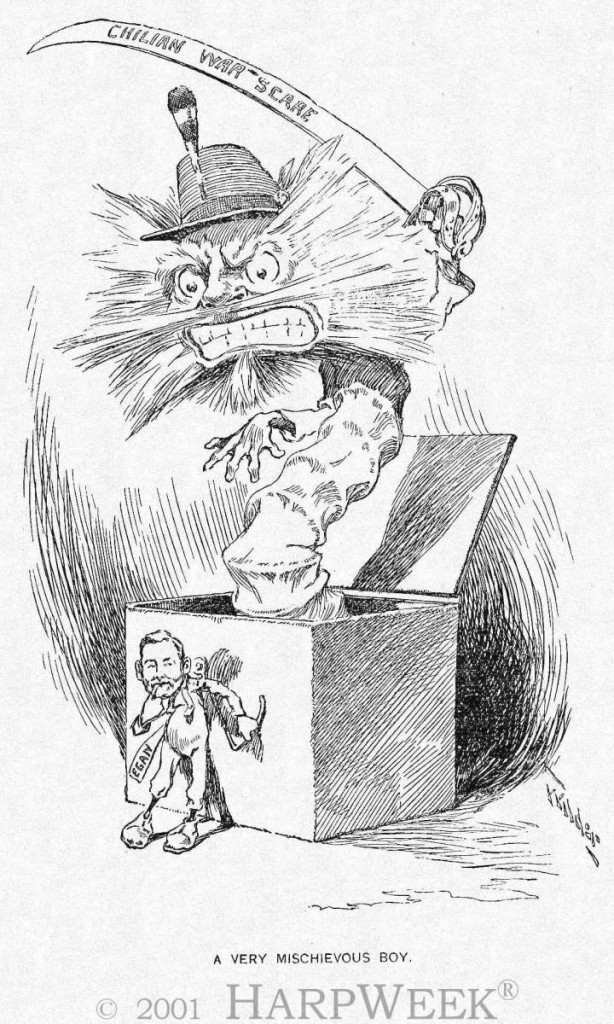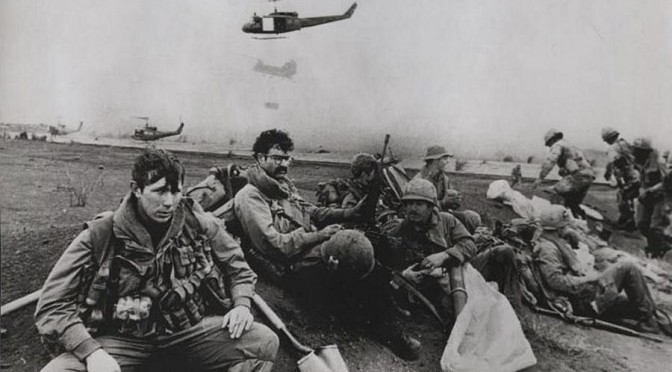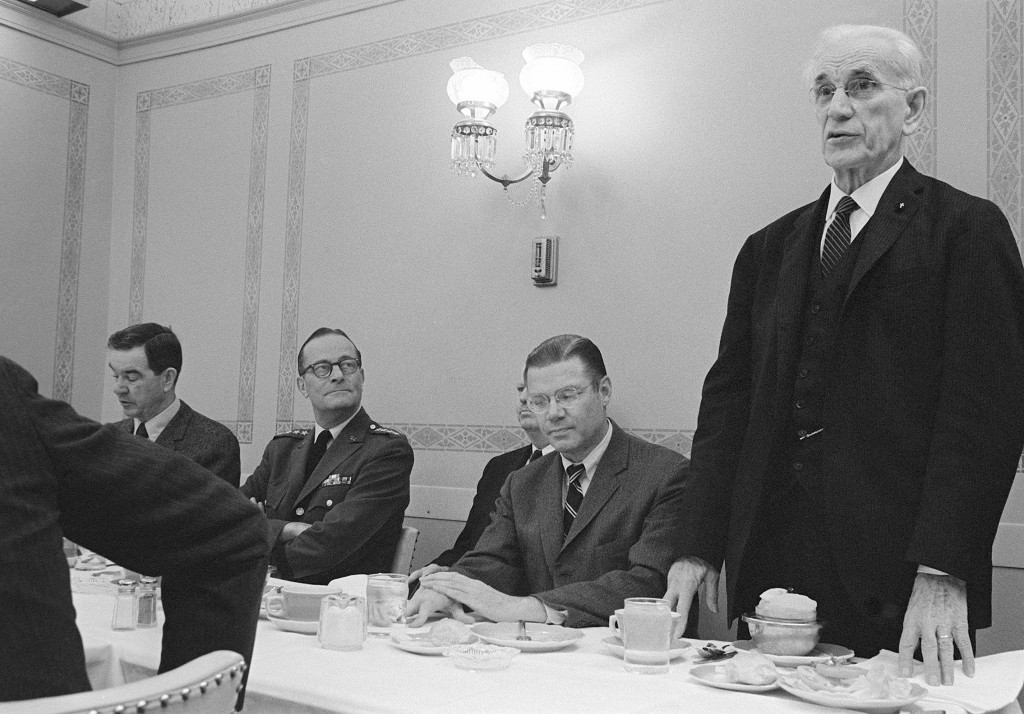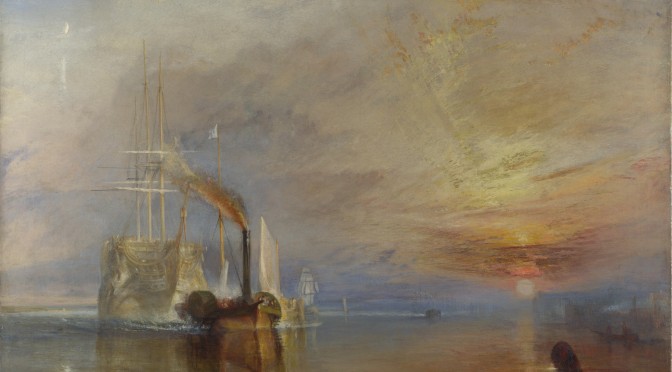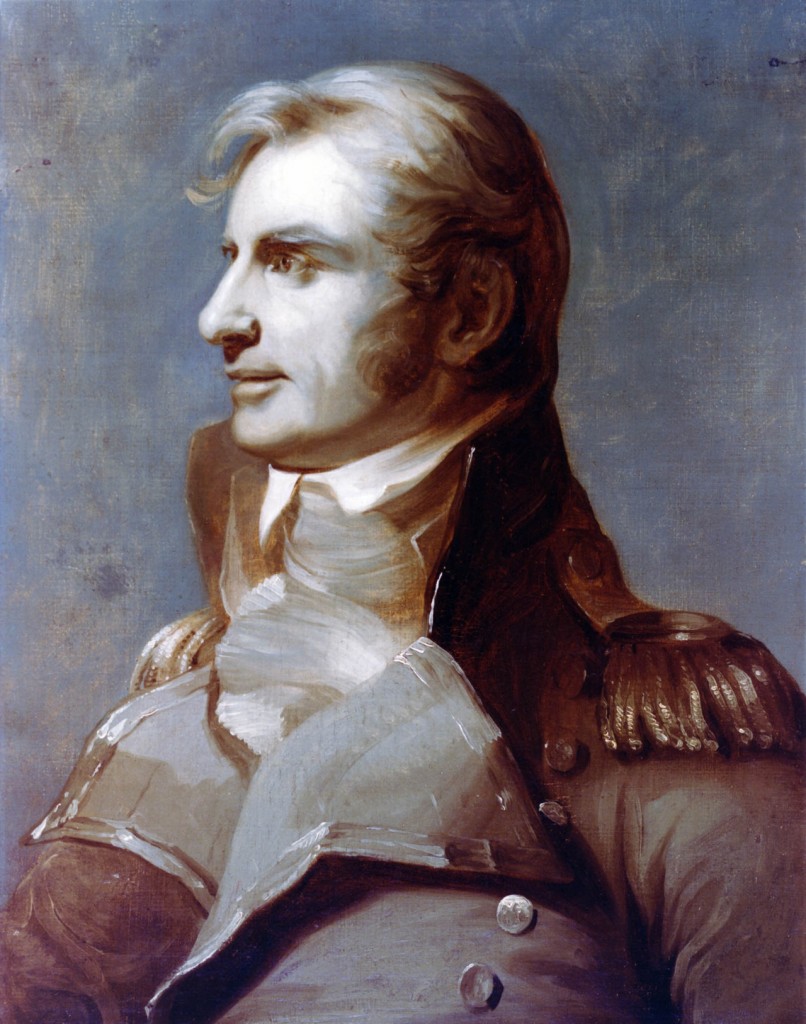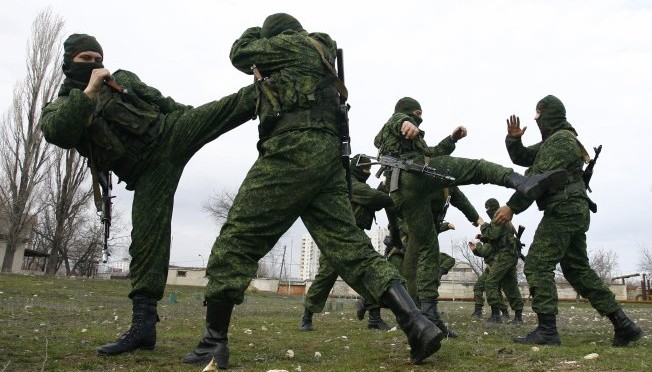Alternate History Topic Week
By Thomas Jamison
On October 16th 1891, a group of USS Baltimore sailors, no doubt happy to have liberty after months at sea, set off to enjoy the delights of Valparaiso, Chile. After several hours (of, let’s be honest, presumably heavy drinking), a scuffle broke out between local Chileans and the American crew. The ensuing violence left two U.S. sailors dead, seventeen injured and a hemispheric relationship in tatters. Unable to resolve the issue locally, the USS Baltimore’s commander telegraphed Washington for instructions. The Chileans, meanwhile, held fast to their jurisdiction over the U.S. personnel, and the investigative proceedings more broadly, as a matter of national sovereignty. From these humble sparks came a war crisis over hemispheric leadership and the relative standing of the United States as a “great power.”
To date, scholars have tended to underestimate the Baltimore Incident as “a mere tempest in a teapot,” or at best a signpost en route to the War of 1898. That the crisis has inspired relatively little comment in English literature should obscure neither its significance to contemporaries nor its enduring relevance to strategic planners. Indeed, the Baltimore Incident might better be understood as an acute manifestation of the larger, chronic competition between the United States and Chile over regional autonomy and control. When, in 1891, Chilean leaders provoked a confrontation with the U.S, they sought political advantage from the crisis (at a domestic and international level) and had good reason to be optimistic. Chile had used its maritime forces and commercial partnerships to defeat Spain (1866), Peru (1884) and to overawe the United States into diplomatic concessions in 1882, 1885 and 1888. By 1891, however, the realities of power-politics in the American Pacific had shifted dramatically. In the United States imperialist sentiment, domestic military production and a dedicated navalist lobby all underwrote a newfound bellicosity and assertiveness. Opinion in Washington held that Chilean regional primacy represented a substantial threat to American expansionism and, moreover, the self-image of the United States in the “great power” system. National “honor” was no idle phrase in the Harrison administration.
At this 1891 juncture for the “dominant position in the Western Hemisphere,” war seemed likely, perhaps even inevitable. As The New York Times reported on Christmas Day 1891: “Looks like a Chilean War, Little Hope Now of a Peaceful Settlement.” Nonetheless, and to the chagrin of many, hostilities were averted in late January 1892 when Chile acceded to U.S. demands. The tantalizing question remains, what might have been? What if the United States and Chile went to War in 1890? What ramifications would conflict have had for the U.S. emergence in the great power system? And as long as we’re entertaining counterfactuals, what might defeat at the hands of “little Chili” have spelled for navalist ambitions and the U.S. role in South America?
The United States, Chile and the Pacific at the Fin-De-Siècle Such an outcome was hardly a remote possibility. In 1884, Chile emerged from the War of the Pacific (its territorial struggle with Peru and Bolivia over nitrate deposits), as the dominant naval power in the Pacific. That result seems as incredible today as it was obvious to contemporary observes. Secretary of the Navy John Long complained that in the 1880s, “the American Navy was inferior to that of any European and at least one South American power. Little Chile, triumphant over Peru, could have sent her Admiral Cochrane and Huascar against San Francisco and the United States would have been unable to repel them.” Likewise, the prize winning essay of the U.S. Naval Institute in 1884 lamented, “in our present condition, Brazil, Chili or the Argentine Republic might send a fleet of ironclads to devastate our seaport cities.” Overseas, in 1881, the London Standard noted (smugly, but with little exaggeration), “The American Navy, if not a phantom fleet, would certainly find it difficult to compete successfully with the Chilean fleet.”
Those observations reflected the scope of Chile’s investment in naval supremacy along the Pacific Slope in the 1880s and 90s. Chilean President Jose Manuel Balmaceda argued in 1891: Chile should be able to resist on its own territory any possible coalition, and if it cannot succeed in attaining the naval power of the great powers, it should at least prove, on the base of a secure port and a fleet proportionate to its resources, that there is no possible profit in starting a war against the Republic of Chile. Resources were appropriated accordingly and with some notable success. The most prolific Chilean naval historian estimated that (in absolute terms) the “peak of Chilean naval power was in 1899.” In 1882 Chile rebuffed—rudely—U.S. attempts to mediate an end to the War of the Pacific. In 1885, it countered U.S. incursions against the Colombians by deploying a gunboat to Panama. Most tangibly, in 1888 Chile annexed Easter Island as a symbol of its hemispheric stature and, more practically, a strategic (coaling/early warning) asset. By 1894, in a revealing detail, Santiago even began to export surplus warships to Japan.
Of the Pacific’s many foreign observes, none eyed Chile’s position with more concern than the United States. The central U.S. political objectives of the late nineteenth century were hemispheric expansion and the development of overseas markets, primarily in Asia—what Seward called “the chief theater of events in the world’s great hereafter.” Both efforts were contingent on an Isthmian Canal and/or sea lines of communication around South America, which in practice pushed the U.S. toward a policy of hemispheric hegemony. Andrew Carnegie captured the spirit of the age in 1882 when he wrote to then Secretary of State James Blaine, “You are exactly right. America is going to control anything and everything on this Continent. That’s settled. . . . No joint arrangements, no entangling alliances with monarchical, war-like Europe. America will take this Continent in hand alone.” In such an environment of imperial ascendancy (U.S.) and regional resistance (Chile), the Baltimore Incident, or some similar provocation, was almost inevitable.
By December 1891, institutional and political incentives had pushed the would-be belligerents to the “ragged edge” of war. That month, as a U.S. task force transited toward South America, the USS Baltimore was replaced on station by the USS Yorktown, commanded by “Fighting Bob” Evans (an officer who could calmly confide in his journal, “I cannot see any good reason why I should not be perfectly civil and polite to [the Chileans], even if I have to shoot them tomorrow.”) Relations deteriorated further when, on New Year’s Eve 1891, the Chileans provocatively fired rockets in the Yorktown’s vicinity, and days later—some sources say —conducted torpedo drills using the U.S. vessel as a notional target. “Fighting Bob” Evans, surveying the scene from the Yorktown was typically blunt, “I don’t see how war can now be avoided.”
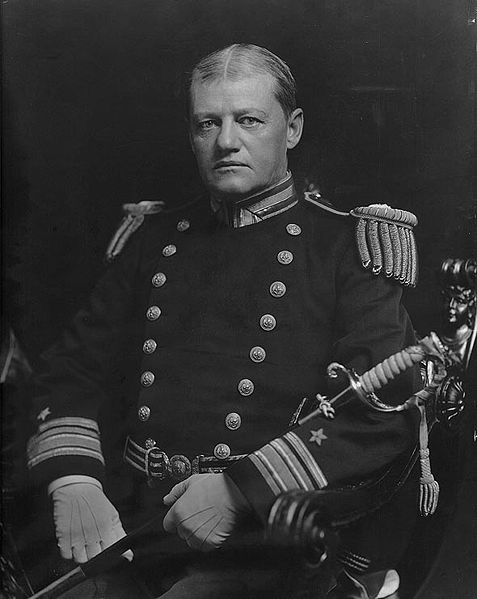
Waging War with “Little Chili” Bombast and hindsight aside, if it came to war between the U.S. and Chile the outcome remained highly contingent. U.S. navalist pretensions belied a central irony of the crisis. American leaders managed to assert that Chile was simultaneously a real threat to U.S. regional hegemony and that it would be relatively easy to defeat in an offensive war. That dissonance spoke to the larger uncertainty about the balance of power in the Pacific. Perceptions of Chilean naval expansion had helped spur U.S. naval expansion in the 1880s, but in 1891 U.S. forces remained relatively limited, and decidedly untested. Tracy, for one, was shocked to learn that “the best American naval expeditionary force which could be mustered at this time numbered scarcely twenty warships.” Moreover, many of these ships teetered on obsolescence. As the Naval Historian Timothy Wolters convincingly documented, in the 1890s:
Naval recapitalization in the United States lagged well behind political debates over, and public perceptions of, the new American navy. Intriguingly, the data show that immediately prior to the country’s war with Spain in 1898, the old navy still consumed about one-third of the navy’s fiscal resources, contributed three-sevenths of the service’s aggregate tonnage, and accounted for just over half of all vessels in the navy’s inventory.
The gap between perception and capability bred miscalculation. Establishing a clear balance of “real power” from which to base strategic planning was frustratingly imprecise.
That was all the more true because naval assessments at the fin-de-siècle were complicated by recent and largely untested developments in naval technology. Innovations in naval architecture (low-freeboard, armored warships; rapid firing guns) and the application of second industrial revolution technologies (electric firing systems; navigational aids; armor piercing shells) rendered traditional assessments of naval efficacy unsure. Chile’s fleet of torpedo boats, for example, presented a novel form of power in the Pacific. It was widely noted that during the Chilean Civil War, the Balmacedist navy had become the first in history to successfully use a propelled “automobile” torpedo to sink another warship. What impact these new weapons might have on the ability of the Chilean’s to defend their coast against aggression was hotly debated.
Complicating matters further were geographic realities that hampered U.S. deployments and ensnared military preparations with European shipyards. The Peruvian minister in Washington, Jose Yrigoyen, appreciated as much, cabling his government to describe “the difficulties the [U.S.] squadron will have in a war with Chile.” Without “coaling station in the Pacific,” he argued perceptibly, the U.S. ships would be forced to ferry coal from San Francisco, a “difficult task, above all if Chile dedicates a few of its ships to capturing this important element of the American squadron.” These geographic challenges injected a sobering realism into the United States’ preparations for war. No less than Mahan wrote, “we are so confident in our bigness and so little realize the great extra load entailed by the distance of Chili, in case of war.” Relatedly, in the winter of 1891, Chile retained the services of a British shipyard for additional ship construction over the objections of the Harrison administration. How the interruption of global supply lines via an Atlantic guerre de course might effect power projection in the Southern Hemisphere defied clear assessment. All this is to say, the war was hardly a foregone conclusion.
Indeed—looking forward to the 1905 Russo-Japanese War—we might even speculate about the use of torpedoes to asymmetrically attack U.S. capital ships (that is to apply a key innovation in second industrial revolution technology to obviate investments in steel, ships, guns etc…). The New York Times certainly did, arguing that “Naval constructors who advocate and powers that have adopted the policy of building larger and larger war ships with constantly- increasing thickness of armor will devote much study and sober thought to [Chile’s] first decisive exhibition of the effectiveness of the automobile torpedo in actual warfare.” Distance, new weapons systems and interruptible lines of communication all suggested that the United States might have fared no better than Spain had a generation (1866-72) earlier in its unsuccessful war with Peru and Chile (one which ended with the Spanish commander committing suicide to avoid humiliation).
If Chile had defeated the United States in a limited regional war, it might have proved a a major setback for Tracy, Mahan and the like. It would likely have undermined U.S. stature in the great power system and elevated Chile on a par with, say, Japan. Indeed in the same way that Russian defeat in 1905 saw it recast as backwards, U.S. defeat might have seriously altered the time, place and manner in which it entered into the European great power system. It might also have seen Chile, backed by a commercial relationship with Great Britain, double-down on its program of navalist expansion and develop into a long-term regional competitor with the United States. It might even have encouraged Santiago to follow up on its territorial annexations (in the Atacama and Easter Island) to become a regional hegemon in its own right.
Conclusion
The resolution of the Baltimore Incident is at once a case study in crisis management and a cautionary tale of military and civilian leaders using war to advance their institutional interests. It is an equally useful reminder (and perhaps necessary corrective) of the limits of U.S. hemispheric control before 1890, and of the speed of the imperial-navalist transformation by 1898. The offensive capabilities of the United States morphed from a near-peer competitor with Chile in the 1880s into those of a global power in under a generation. In this sense, the Baltimore Incident is a window onto the United States “adapting to the status of a world power” amid a period of technological change and imperial rivalry. The great diplomatic historian Ernest May argued that the United States became “a world power in many respects comparable to Great Britain or Russia or Imperial Germany” after the War of 1898. Looking back a decade, the Baltimore Incident marks an important precedent in a longer process of ascendancy. Considering alternative outcomes (namely defeat) further reminds us of that ascendancy’s contingent nature. As a nomological exercise, the Baltimore Incident suggests a raft conclusions. Namely, that regional actors often resist imperial hegemony in order to secure domestic cohesion; that military bureaucracies incentivize the militarization of foreign policy; and that technological progress can rapidly destabilize the balance of power, encouraging misperceptions and bellicosity. These tendencies belong as much to the twenty first century as they do the nineteenth. Parallels between the Baltimore Incident and recent Sino-Japanese tensions, to name one possible example, are almost irresistible. Consider in this analogy China as the Harrisonian United States and Japan as Chile; supported then, as now, by the world’s leading commercial power. It is conceivable, as in 1891, that a minor incident, like an attack on a foreign owned business, could encourage nationalist posturing in Beijing as a means to (1) rally domestic support, (2) advance the interests of recapitalizing military forces (a process ongoing in both China and Japan), and (3) assert regional primacy. That possibility should be especially concerning because of the comparative proximity of China and Japan and the profound uncertainties created by the militarization of digital technology. A critical perspective on the Baltimore Incident should sensitize policymakers to this relevant, but under-appreciated war scare. It should also reinforce the imperative of clear assessments of power as a tool for conflict mitigation amid the exaggerations of modern-day nationalism.
Tommy Jamison is a PhD candidate in International History at Harvard University. From 2009 to 2014 he served as an officer in the U.S. Navy. The views expressed here are his own.


